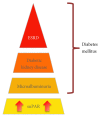Soluble Urokinase Receptor and the Kidney Response in Diabetes Mellitus
- PMID: 28596971
- PMCID: PMC5449757
- DOI: 10.1155/2017/3232848
Soluble Urokinase Receptor and the Kidney Response in Diabetes Mellitus
Abstract
Diabetic nephropathy (DN) is the leading cause of end-stage renal disease (ESRD) worldwide. DN typically manifests by glomerular hyperfiltration and microalbuminuria; then, the disease progresses to impaired glomerular filtration rate, which leads to ESRD. Treatment options for DN include the strict control of blood glucose levels and pressure (e.g., intraglomerular hypertension). However, the search for novel therapeutic strategies is ongoing. These include seeking specific molecules that contribute to the development and progression of DN to potentially interfere with these "molecular targets" as well as with the cellular targets within the kidney such as podocytes, which play a major role in the pathogenesis of DN. Recently, podocyte membrane protein urokinase receptor (uPAR) and its circulating form (suPAR) are found to be significantly induced in glomeruli and sera of DN patients, respectively, and elevated suPAR levels predicted diabetic kidney disease years before the occurrence of microalbuminuria. The intent of this review is to summarize the emerging evidence of uPAR and suPAR in the clinical manifestations of DN. The identification of specific pathways that govern DN will help us build a more comprehensive molecular model for the pathogenesis of the disease that can inform new opportunities for treatment.
Figures


Similar articles
-
Urokinase plasminogen activator receptor and its soluble form in common biopsy-proven kidney diseases and in staging of diabetic nephropathy.Clin Biochem. 2015 Dec;48(18):1324-9. doi: 10.1016/j.clinbiochem.2015.07.001. Epub 2015 Jul 8. Clin Biochem. 2015. PMID: 26162494
-
Inhibiting the urokinase-type plasminogen activator receptor system recovers STZ-induced diabetic nephropathy.J Cell Mol Med. 2019 Feb;23(2):1034-1049. doi: 10.1111/jcmm.14004. Epub 2018 Nov 13. J Cell Mol Med. 2019. PMID: 30426662 Free PMC article.
-
Glomerular podocytes in diabetic renal disease.Adv Clin Exp Med. 2019 Dec;28(12):1711-1715. doi: 10.17219/acem/104534. Adv Clin Exp Med. 2019. PMID: 31851794 Review.
-
Pyruvate kinase M2 activation may protect against the progression of diabetic glomerular pathology and mitochondrial dysfunction.Nat Med. 2017 Jun;23(6):753-762. doi: 10.1038/nm.4328. Epub 2017 Apr 24. Nat Med. 2017. PMID: 28436957 Free PMC article.
-
Rethinking glomerular basement membrane thickening in diabetic nephropathy: adaptive or pathogenic?Am J Physiol Renal Physiol. 2016 Nov 1;311(5):F831-F843. doi: 10.1152/ajprenal.00313.2016. Epub 2016 Aug 31. Am J Physiol Renal Physiol. 2016. PMID: 27582102 Free PMC article. Review.
Cited by
-
The Predictive Value of Soluble Urokinase-Type Plasminogen Activator Receptor in Contrast-Induced Acute Kidney Injury in Patients Undergoing Percutaneous Coronary Intervention.Int J Gen Med. 2021 Oct 7;14:6497-6504. doi: 10.2147/IJGM.S339075. eCollection 2021. Int J Gen Med. 2021. PMID: 34675617 Free PMC article.
-
suPAR and WT1 modify the adhesion of podocytes and are related to proteinuria in class IV lupus nephritis.J Transl Autoimmun. 2023 Oct 13;7:100216. doi: 10.1016/j.jtauto.2023.100216. eCollection 2023 Dec. J Transl Autoimmun. 2023. PMID: 37868110 Free PMC article.
-
[Focus nephrology : Intensive medical care studies from 2019/2020].Anaesthesist. 2021 Mar;70(3):250-256. doi: 10.1007/s00101-020-00856-w. Anaesthesist. 2021. PMID: 33103208 German. No abstract available.
-
Role of Transient Receptor Potential Canonical Channel 6 (TRPC6) in Diabetic Kidney Disease by Regulating Podocyte Actin Cytoskeleton Rearrangement.J Diabetes Res. 2020 Jan 3;2020:6897390. doi: 10.1155/2020/6897390. eCollection 2020. J Diabetes Res. 2020. PMID: 31998809 Free PMC article. Review.
-
Glomerular filtration barrier dysfunction in a self-limiting, RNA virus-induced glomerulopathy resembles findings in idiopathic nephrotic syndromes.Sci Rep. 2020 Nov 5;10(1):19117. doi: 10.1038/s41598-020-76050-0. Sci Rep. 2020. PMID: 33154421 Free PMC article.
References
-
- Eknoyan G., Hostetter T., Bakris G. L., et al. Proteinuria and other markers of chronic kidney disease: a position statement of the national kidney foundation (NKF) and the national institute of diabetes and digestive and kidney diseases (NIDDK) American Journal of Kidney Diseases. 2003;42(4):617–622. doi: 10.1016/S0272-6386(03)00826-6. - DOI - PubMed
Publication types
MeSH terms
Substances
Grants and funding
LinkOut - more resources
Full Text Sources
Other Literature Sources
Medical

